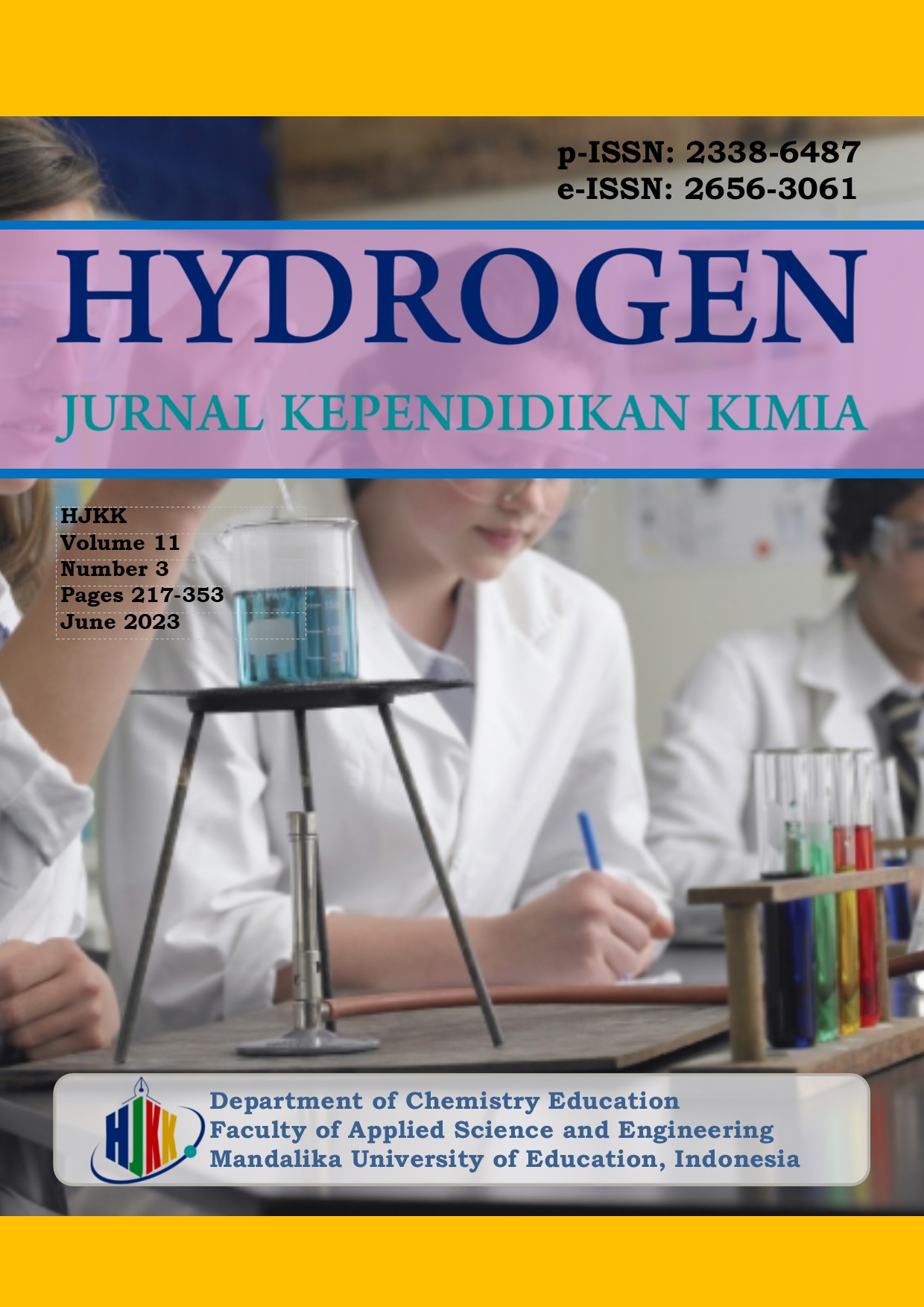Utilization of Borrasus flabellifer L. Palm Coir Activated with Potassium Hydroxide (KOH) as an Efficient Adsorbent for Rhodamine B Dye Removal
DOI:
https://doi.org/10.33394/hjkk.v11i3.7673Keywords:
Adsorption, Activated carbon, Rhodamin B, Palm coirAbstract
References
Amri, A. 2017. Potensi Limbah Tongkol Jagung dan Sabut Buah Pinang sebagai Adsorben. Jurnal FMIPA dan Kesehatan. 2(1): 23-30.
Agustina, L. 2022. Pemanfaatan Arang Aktif dari Limbah Serbuk Gergaji Kayu Bangkirai (Shorea Laefivolia Eudert) sebagai Adsorben Zat Warna Rhodamin B. Jurnal Atomik. 6(2): 119-123
Asnawati, R. R. 2017. Penentuan Kapasitas adsorpsi Selulosa Terhadap Rhodmin B dalam Sistem Dinamis. Jurnal Kimia Riset, 2(1): 23-29
Ariyani, Putri A.R., Eka R.P., Fathoni R. 2020. Pemanfaatan Kulit Singkong Sebagai Bahan Baku Arang Aktif dengan Variasi Konsentrasi NaOH dan Suhu. Jurnal Teknik Kimia. 6(1): 7-10
Esterlita, M.O., Herlina, N., 2015. Pengaruh Penambahan Aktivator ZnCl2, KOH, H3PO4 Dalam Pembuatan Karbon Aktif Dari PelepahAren (Arenga Pinnata). Jurnal Teknik Kimia USU. 4(1): 47-52
Fariha. 2020. Karakterisasi Sabut Siwalan (Borassus flabellifer L.) dan Kulit Pisang Raja (Musa paradisiaca var. Raja) dalam Proses Produksi Bioetanol. Prosiding Seminar Nasional. pp. 1-7
Faisal, dan Pato, U. 2021. Studi Konsentrasi Kalium Hidroksil (KOH) Terhadap Kualitas Karbon Aktif Tempurung Kluwak. Jurnal Pertanian. 8(1): 1-13
Ifa,L., Pakala, R.F., Burhan, W.R., Jaya, F., Majid, A.R 2020. Pemanfaatan Sabut Buah Kelapa Sebagai Bioadsoerben Logam Berat Pb(II) pada Air Limbah Industri. Journal of Chemical. 5(1): 54-60
Laos, E.L., dan Selan, A. 2016. Pemanfaatan Kulit Singkong Sebagai Bahan Baku Karbon Aktif. Jurnal Ilmu Pendidikan Fisika. 1(1): 32-36
Lano, L.A., Ledo, M.E.S., dan Nitsae, M. 2020. Pembuatan Arang Aktif dari Tempurung Siwalan (Borassus Flabellifer L.) yang Diaktivasi dengan Kalium Hidroksida (KOH). Jurnal Ilmiah Ilmu-Ilmu Hayati. 5(1): 8-15.
Musafira, N.M. Adam, dan Dwi J. P. 2019. Pemanfaatan Limbah Kulit Buah Pisang Kepok (Musa paradisiaci) Sebagai Biosorben Zat Warna Rhodamin B. Jurnal Riset Kimia. 5(3): 308-314
Nafi’ah, R. 2016. Kinetika Adsorpsi Pb (II) dengan Adsorben Arang Aktif dari Sabut Siwalan. Jurnal Farmasi Sains dan Praktis. 1(2): 28-35.
Nurlaili, T. 2017. Pemanfaatan Limbah Cangkang Telur Ayam sebagai Adsorben Zat Warna Methyl Orange Dalam Larutan. Inovasi Teknik Kimia. 2(2): 11-14
Purnamawati, H. dan Utami, B. 2014. Pemanfaatan Limbah Kulit Buah Kakao (Theobroma cacao L.) sebagai Zat warna Rhodamin B. Prosiding Seminar Nasional Fisika dan Pendidikan Fisika, pp. 13-18
Pradhana, P., G. 2021. Pembuatan Adsorben dari Ampas Biji Kopi sebagai Arang Aktif Untuk Penyerapan Zat Warna Rhodamin B. Prosiding Seminar Nasional Kimia. pp. 58-66
Rohmah, A. 2014. Pengaruh Waktu Karbonisasi pada Pembuatan Karbon Aktif Berbahan Baku Sekam Padi dengan Aktivator KOH . Jurnal Teknik Kimia. 3(1): 19-27
Sahara, E., Gayatri, P. S. dan Suarya, P. 2018. Adsorpsi Zat Warna Rhodamin-B dalam Larutan oleh Arang Aktif Batang Tanaman Gumitir Teraktivasi Asam Fosfat. Cakra kimia (Indonesian E-Journal of Applied Chemistry). 6(1): 37-45.
Sembiring, M.T., dan Sinaga, T. 2003. Arang Aktif (Pengenalan dan Proses Pembuatannya). Jurnal Usu Digital Library. pp. 1-9
Shofiyani, Y., Rahmiyati, dan Titin, A.Z. 2020. Nano siloka Berbahan dasar Batu Padas Sebagai adsoben zat warna Sintesis Rhodamin B. Indonesia Journal Of Chemical Science. 9(3): 188-193
Sitanggang, T., Shofiyani, dan Intan, S. 2017. Karakterisasi Adsorpsi Pb (II) Pada Karbon Aktif dari Sabut Pinang (Areca Catechu L.) Teraktivasi H2SO4. Jurnal JKK. 6(4): 49-55
Sri Rahayu, N., Herawati, dan Mohammad, W. 2020. Sintesis nanopartikel Mangan Oksidasi dengan Metode Sol Gel dan Uji Ativitas Katalitik Tehadap Degradasi Zat Warna Rhodamin B. Jurnal Chemical. 2(1): 190-199
Sudibandriyo, M., dan Lydia. 2011. Karakteristik Luas Permukaan Karbon Aktif dari Ampas Tebu dengan Aktivasi Kimia. Jurnal Teknik Kimia Indonesia. 10(3): 149-156
Syarippuddin, M.S., Harjanto, dan Septian, B.C. 2019. Pembuatan dan Karakterisasi Arang Aktif dari Bonggol Singkong dengan Aktifasi Fisika. Prosiding seminar Nasional penelitian dan Pengabdian kepada Masyarakat. Prosiding Seminar Nasional. pp. 94-99
Verayana., Mardjan, P., dan Hendri, I. 2018. Pengaruh Aktivator HCl dan H3PO4 terhadap Karakteristik (Morfologi Pori) Arang Aktif Tempurung Kelapa serta Uji Adsorpsi pada Logam Timbal (Pb). Jurnal Pendidikan dan Sains Kimia. 13(1): 67-75.
Downloads
Published
How to Cite
Issue
Section
Citation Check
License
License and Publishing Agreement
In submitting the manuscript to the journal, the authors certify that:
- They are authorized by their co-authors to enter into these arrangements.
- The work described has not been formally published before, except in the form of an abstract or as part of a published lecture, review, thesis, or overlay journal.
- That it is not under consideration for publication elsewhere,
- That its publication has been approved by all the author(s) and by the responsible authorities – tacitly or explicitly – of the institutes where the work has been carried out.
- They secure the right to reproduce any material that has already been published or copyrighted elsewhere.
- They agree to the following license and publishing agreement.
Copyright
Authors who publish with Hydrogen: Jurnal Kependidikan Kimia agree to the following terms:
- Authors retain copyright and grant the journal right of first publication with the work simultaneously licensed under a Creative Commons Attribution License (CC BY-SA 4.0) that allows others to share the work with an acknowledgment of the work's authorship and initial publication in this journal.Â
- Authors are able to enter into separate, additional contractual arrangements for the non-exclusive distribution of the journal's published version of the work (e.g., post it to an institutional repository or publish it in a book), with an acknowledgment of its initial publication in this journal.
- Authors are permitted and encouraged to post their work online (e.g., in institutional repositories or on their website) prior to and during the submission process, as it can lead to productive exchanges, as well as earlier and greater citation of published work.
Licensing for Data Publication
Hydrogen: Jurnal Kependidikan Kimia uses a variety of waivers and licenses, that are specifically designed for and appropriate for the treatment of data: Open Data Commons Attribution License, http://www.opendatacommons.org/licenses/by/1.0/ (default) Other data publishing licenses may be allowed as exceptions (subject to approval by the editor on a case-by-case basis) and should be justified with a written statement from the author, which will be published with the article.







